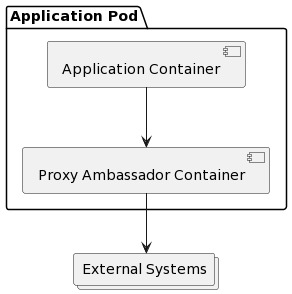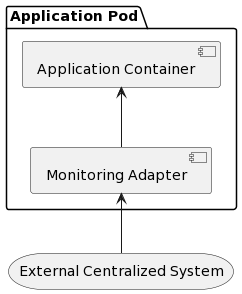Composite Container Patterns in K8S From a Developer's Perspective
The goal of this article is to present 3 popular extensibility architectural patterns from a developer's perspective using well-known programming principles.
Join the DZone community and get the full member experience.
Join For FreeBuilding complex container-based architectures is not very different from programming in terms of applying design best practices and principles. The goal of this article is to present three popular extensibility architectural patterns from a developer's perspective using well-known programming principles.
Let's start with the Single Responsibility Principle. According to R. Martin, "A class should have only one reason to change." But classes are abstractions used to simplify real-world problems and represent software components. Hence, a component should have only one reason to change over time. Software services and microservices in particular are also components (runtime components) and should have only one reason to change. Microservices are supposed to be a single deployable unit, meaning they are deployed independently of other components and can have as many instances as needed.
But is that always true? Are microservices always deployed as a single unit?
In Kubernetes, the embodiment of a microservice is a Pod. A Pod is defined as a group of containers that share resources like file systems, kernel namespaces, and an IP address. The Pod is the atomic unit of scheduling in a Kubernetes cluster and each Pod is meant to run a single instance of a given application.
According to the documentation, "Pods are designed to support multiple cooperating processes (as containers) that form a cohesive unit of service. The containers in a Pod are automatically co-located and co-scheduled on the same physical or virtual machine in the cluster. Scaling an application horizontally means replicating Pods. According to the Kubernetes documentation, Pods can be configured using two strategies:
- Pods that run a single container: The "one-container-per-Pod" model is the most common Kubernetes use case; the Pod is a wrapper around a single container and Kubernetes manages Pods rather than managing the containers directly.
- Pods that run multiple containers working together: A Pod can encapsulate an application composed of multiple co-located containers that are tightly coupled and need to share resources. These co-located containers form a single cohesive unit of service—for example, one container serving data stored in a shared volume to the public, while a separate sidecar container refreshes or updates those files. The Pod wraps these containers, storage resources, and an ephemeral network identity together as a single unit."
The answer is:
NO! Microservices are NOT always deployed as a single unit!
Next to some popular architectural patterns for the cloud like scalability patterns, deployment and reliability patterns are extensibility architectural patterns. We will have a closer look at the three most popular extensibility patterns for cloud architectures:
- Sidecar pattern
- Ambassador pattern
- Adapter pattern
Sidecar Pattern
Problem
Each deployable service/application has its own "reason to change," or responsibility. However, in addition to its core functionality it needs to do other things called in the software developer terminology "cross-cutting concerns." One example is the collection of performance metrics that need to be sent to a monitoring service. Another one is logging events and sending them to a distributed logging service. I called them cross-cutting concerns, as they do not directly relate to business logic and are needed by multiple services, they basically represent reusable functionality that needs to be part of each deployed unit.
Solution
The solution to that problem is called the sidecar pattern and imposes the creation of an additional container called a sidecar container. Sidecar containers are an extension of the main container following the Open-Closed design principle (opened for extension, closed for modification). They are tightly coupled with the "main" container in terms of deployment as they are deployed as part of the same Pod but are still easy to replace and do not break the single responsibility of the extended container. Furthermore, the achieved modularity allows for isolated testing of business-related functionality and additional helper services like event logging or monitoring. The communication of the two containers is fast and reliable and they share access to the same resources enabling the helper component to provide reusable infrastructure-related services. In addition, it is applicable to many types of services solving the issue with heterogeneity in terms of different technologies used. The upgrade of the sidecar components is also straightforward as it usually means the upgrade of a Docker container version and redeploying using for example the no-down-time Kubernetes strategies.

Ambassador Containers
Problem
Deployed services do not function in isolation. They usually communicate over the network to other services even outside the application or software platform controlled by a single organization. Integrations between components in general imply integration with external APIs and also dealing with failures or unavailability of external systems. A common practice for external systems integration is to define the so-called API Facade, an internal API that hides the complexity of external system APIs. The role of the API Facades is to isolate the external dependencies providing an implementation of the internal API definition and taking care of security and routing if needed. In addition, failures and unavailability of external systems are usually handled using some common patterns like the Retry Pattern, Circuit Breaker Pattern, and sometimes backed by Local Caching. All these technicalities would complicate the main service and appear to be candidates for a helper container.
Solution
The solution to that problem is called Ambassador Pattern and implies the creation of an additional container called an Ambassador container. Ambassador containers proxy a local connection to the world, they are basically a type of Sidecar container. This composition of containers is powerful, not just because of the separation of concerns and the fact that different teams can easily own the components but it also allows for an easy mocking of external services for local development environments.

Adapter Containers
Problem
There are still many monolith systems planned for migration to more lightweight architectures. Migrations, though, can not happen in one pass, and it is also risky to wait for the rewriting of a whole system for years while also supporting the addition of new features in both versions of the system. Migrations should happen in small pieces publishing separate services and integrating them one by one. That process repeats until the legacy monolith system is gone. So we have a new part of the system supporting new APIs and an old part that still supports old APIs. For example, we might have newly implemented REST services and still have some old SOAP-based services. We need something that takes care of exposing the old functionality as if all the services were migrated and can be integrated by the clients' systems.
Solution
The solution to that problem is called Adapter or Anti-Corruption pattern. The Adapter container takes care of translating from one communication protocol to another and from one data model to another while hiding the actual service from the external world. Furthermore, the Adapter container can provide two-way communication. If the legacy system needs to communicate with the new services it could also be the adapting component for that communication serving as a kind of an Ambassador container until the migration is finalized.

In this article, we saw how container composition provides an extensibility mechanism without an actual change of the main application container providing stability and reusability by allowing the composite pod to be treated as any other simple pod exposing a single and simple service in a microservice architecture. One would ask why not use a library and share it across many containers. Well, that is also a solution but then we are facing the shared responsibility problem of introducing coupling between all the services using it. In addition, heterogeneous services would require rewriting the libraries using all the supported languages. That also breaks the Single Responsibility Principle, which we would in any case like to keep.
Opinions expressed by DZone contributors are their own.

Comments